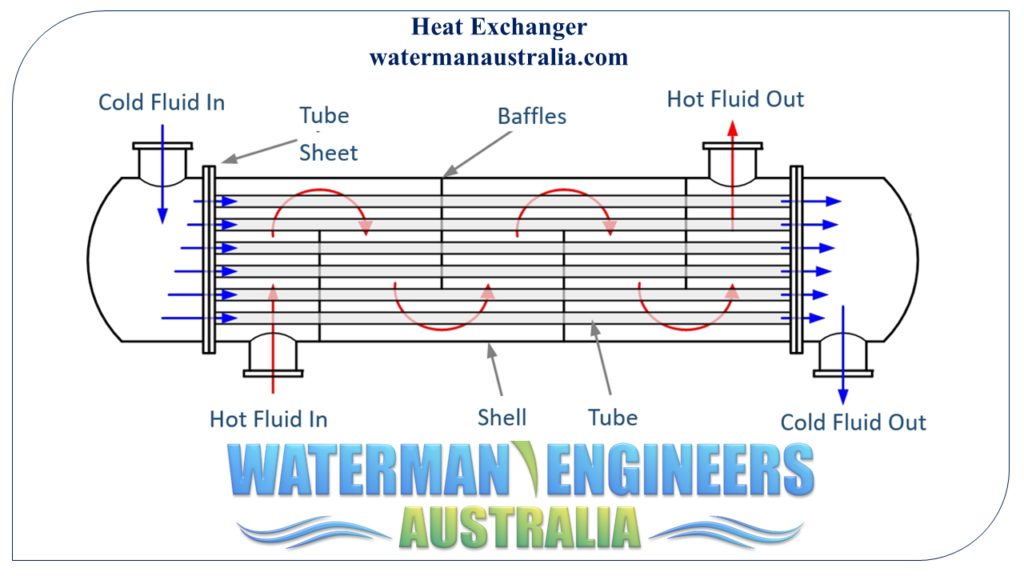
A heat exchanger is a device that allows for the transmission of heat between two different media without any physical contact between them. Heat exchangers work on the idea that thermal energy can be transferred from a hot fluid to a cold fluid. Heat exchangers provide for precise temperature regulation, improving energy efficiency and system functionality by transferring heat between two fluids.
Power plants, chemical plants, HVAC (heating, ventilation, and air conditioning) systems, supermarkets, and many more all employ heat exchangers. They can be found in commonplace home products like air conditioners and water heaters.
In this article, we'll learn about heat exchangers, what they are, how they work, and the different kinds there are. The article also details the common uses and factors to consider when choosing a heat exchanger.
eleven. Tubesheets. Tubesheets below a hundred mm thick are generally constructed from plate material. Thicker tubesheets, or for prime integrity services, are produced from forged discs. Clad plate is often employed where by large alloy substance is required for system reasons. A clad tubesheet consists of a carbon or lower alloy backing plate of adequate thickness to satisfy the force vessel style and design code, using a layer of the higher alloy material bonded on to it by welding or by explosion cladding. TEMA gives style and design regulations to compute the tubesheet thickness, which give very similar but not similar results to the rules in ASME and BS5500. What's more, it specifies tolerances for tube hole diameter, ligament width and for drill drift.
But do Take note that it would not raise the cost of the goods to you in almost any way or identify our verdict on a product/company.
The API code and a few consumer technical specs call for toughness welds; replacing the tube expansion into grooves + seal weld by combining the two mechanical energy and leak tightness is usually a weaker Alternative and isn't advisable.
Heat exchanger engineering and design and style has arrive a good distance over time and There have been a gradual development to reduce the size and compactness of radiators, chillers, evaporators and condensers to further improve conversion efficiencies.
Heat Exchanger Style Information: A Simple Guidebook for Setting up, Choosing and Designing of Shell and Tube Exchangers usually takes users on the phase-by-step tutorial to the look of heat exchangers in day by day practice, demonstrating how to determine the successful driving temperature change for heat transfer. Customers will learn the way to determine heat transfer coefficients for convective heat transfer, condensing, and evaporating utilizing easy equations. Dew and bubble factors and contours are coated, with all calculations� supported with illustrations. This functional guide is built to assist engineers clear up regular challenges they may face inside their day-to-day function, and will even serve as a helpful reference for college students Understanding about the sector.
More compact measurements could well be difficult to thoroughly clean and larger measurements are made use of only in strain-fall-restricting cases. Lesser-diameter tubes needs to be favored if the tube-aspect layout stress is incredibly higher, so as to decrease the tube thickness.
In spite of this low benefit—for an Office environment constructing and very hot summer time local weather—, to the look of the EAHX for standalone Business room cooling it signifies a complicated prerequisite.
The pressurized parts on the shell and tube exchanger are meant to be in accordance with a force vessel style code which include ASME VIII (1993) or BS5500 (1994).
Better ambient air temperatures would require much more surface area spot and bigger bays to meet the same responsibility. Plot or transportation constraints may Restrict the width or measurement of each bay, thus escalating the full variety of bays required.
When the ductwork isn’t particularly a A part of both a gas or electrical furnace, it really is A vital component that allows your home to generally be properly heated.
Natural gas is distributed all over the nation into cities and into your own household. Because it travels from a person stage to another, it changes pressures. By the point it reaches your own home, the pressure is normally 8-12 inches of water column (the measurement used to evaluate fuel strain).
Even though the tools style and design specification ready from the operator/user seeks to serve the perform of familiarizing the designer with the general plant needs, the breadth and depth of data found in the “specs” may differ significantly. The fabric furnished In this particular chapter is aimed to provide the designer with an summary of these “trans-structure” subjects. Engineers engaged in specification development, and plant personnel responsible for heat exchanger inspection and routine maintenance, may even discover the knowledge introduced listed here practical within their function.
In the event the effect variable exceeds the TEMA boundaries, impingement security is required. The TEMA criteria specify various rho-v-2 restrictions for erosive fluids and nonerosive fluids.
Built to help engineers remedy normal complications they might experience within their day-to-day operate, but in addition perfect being a handy reference Designing of heat exchanger manufacturer for college kids Discovering about the field